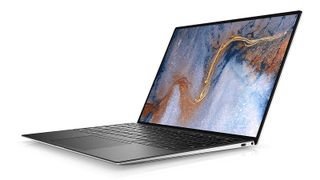

When you’re weighing up the Dell XPS 13 vs Dell XPS 15 in 2022 you know you’re looking at two of the best Dell laptops, and two of the best laptops full stop. But what you really need to know is what the difference are beyond the size, and how to choose between them. That’s what we’re here for.
We’ll run the rule on what splits these two, from design to performance, so that you’re fully armed to make an informed decision within your budget.
Both of these laptops are premium pieces of kit, and you can get a more in depth breakdown on one of the best student laptops in our Dell XPS 13 review – but let's dive into how the big version compares to it.
Dell XPS 13 vs Dell XPS 15: Design & Screen

The Dell XPS 13 in two colours.
Unsurprisingly, the Dell XPS 13 vs Dell XPS 15 look similar – but that doesn’t mean they’re identical. Obviously, one's bigger than the other: the XPS 13 has a 13.4-inch screen compared to the XPS 15’s 15.6-inches.
This means that the Dell XPS 13 is smaller and lighter, and why it finds its way on to our best lightweight laptop list when its bigger brother misses out. Moving from portability to ports, the Dell XPS 15 is a little more well equipped.
The Dell XPS 13 has two USB-C/Thunderbolt 3 ports, one regular USB-C port, a 3.5mm headphone jack, and a microSD card reader. The XPS 15 swaps out the XPS 13’s microSD for a full-sized SD card reader, but otherwise is identical for connectivity.
The screen is where you'll see a bit more difference. The Dell XPS 13 and XPS 15 both feature Dell’s Infinity Edge displays, which means small borders, for fitting more screen into a smaller overall body. The XPS 13 has a 16:9 display, while the XPS 15 has a 16:10 display. Both displays are available with Full HD or 4K resolutions – this means choosing either 1920x1080 or 3840x2160 in the XPS 13, and 1920x1200 or 3840x2400 on the XPS 15. Both offer 100% sRGB colour support from their IPS panels, but the XPS 15 also promises 94% DCI-P3 colour coverage.
The XPS 13's screen is rated for a brightness of 400 nits, while the XPS 15's is 25% bright at 500 nits, making it more visible in bright light. The XPS 15 also supports Dolby Vision HDR, which should make movies look better when watched on it (though the brightness isn't high enough to truly take advantage of this).
Sign up to the T3 newsletter for smarter living straight to your inbox
Get all the latest news, reviews, deals and buying guides on gorgeous tech, home and active products from the T3 experts
Dell XPS 13 vs Dell XPS 15: Specs & Performance

The Dell XPS 15.
Comparing specifications on laptops can get a bit complicated as there are multiple builds available depending on what you want or can afford. This is also true of the Dell XPS 13 and Dell XPS 15, so we’ll take them one at a time.
The XPS 13 supports Intel’s 10th generation processors i3-1005G1 (dual-core, 1.2GHz), i5-1035G1 (quad-core, 1.0GHz) and i7-1065G7 (quad-core, 1.3GHz). It has RAM options of 8GB or 16GB and you'll get Intel UHD or Iris Plus integrated graphics, depending on the processor you choose.
The XPS 15 also supports Intel’s 10th generation processors, specifically the i5-10300H (quad-core, 2.5GHz) and i7-10750H (six-core, 2.6GHz). It has RAM options from 8GB all the way up to 64GB, and for graphics you can stick with Intel's integrated UHD graphics or add a 4GB Nvidia 1650 Ti.
What that all means is that the Dell XPS 15 is capable of being a much more powerful machine. The least processor in the XPS 15 is capable of chewing through challenging tasks faster than the most powerful processor in the XPS 13. Go for the higher-tier options in the XPS 15 for RAM and graphics and you’ll see major differences, assuming you’re willing to pay for the highest specs.
It important to say, though, that even at the low-end of their spec capabilities these are both impressive, fast premium machines. It's only for intensive, pro-style tasks or gaming that the extra processing power of the XPS 15 comes into its own. The XPS 13 still has plenty of power, especially for more standard work – documents, web browsing, standard photo editing and so on.
When it comes to storage, the XPS 13 offers 128GB, 256GB or 512GB of capacity. The XPS 15 offers 512GB or 1TB options only. Both machines use fast NVMe SSD storage, which is part of what make them feel so fast – it's extremely fast to fetch or write data.
When it comes to battery life, at the high-end with 4K touchscreen displays both machines will last around 8 hours while lower-end models should hit between 12 and 14 hours. This will vary massively depending on your task, though – gaming will reduce that drastically, for example.
Dell XPS 13 vs Dell XPS 15: Price & Verdict:

The Dell XPS 13.
For the same reason as the specifications, it’s hard to compare the prices of the Dell XPS 13 and the Dell XPS 15. The XPS 13 starts off cheaper, but can be scaled into a very capable ultra-portable machine. The XPS 15 starts off more expensive, and has several more expensive upgrade options that could double its price if you go all in.
What you get is really down to what you want here. The XPS 13 is a fantastic, lightweight, portable laptop; the XPS 15 can be augmented into an ultra-powerful, top-tier machine that's still impressively portable.
If you’re into gaming, then the larger machine is your only option, really. If you need a machine for pro video editing or equivalent tasks, it's the smart buy in that case, too.
For most people, we'd recommend the XPS 13 because of its affordability and more compact size, but if you need higher specs or simply want a bigger screen, the XPS 15 is also an excellent choice.
Make sure you check our Dell discount codes to bag the best deal.
-
 Apple TV gets a free update that makes it more simple to use
Apple TV gets a free update that makes it more simple to useApple has released tvOS 18.4 with a few design tweaks for its TV boxes
By Rik Henderson Published
-
 Tired of a bad lower back? Bulletproof it with these three simple exercises
Tired of a bad lower back? Bulletproof it with these three simple exercisesA fitness expert shares three easy moves you can do straight from the comfort of your home
By Bryony Firth-Bernard Published
